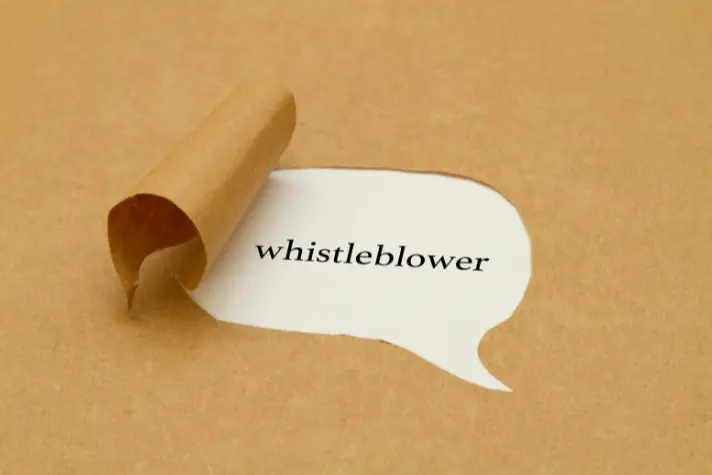
Where the pursuit of innovation intersects with the imperative of ethical conduct, compliance officers stand as guardians against the risks posed by whistleblowing.
Whistleblowers, vital sentinels in this landscape, unveil critical misconduct – from clinical trial manipulation to financial fraud – ensuring patient safety and fostering accountability.
The repercussions faced by life sciences companies, including financial penalties and reputational damage, underscore the need for a proactive approach.
This blog explores key strategies for compliance officers to navigate these challenges effectively, emphasizing the creation of a culture of open communication, leveraging compliance monitoring to detect potential risks of policy violations, proactive risk assessment, and robust response mechanisms.
5 Best Practices for Compliance Officers to Minimize Whistleblower Risks
By delving into these best practices, compliance professionals can fortify their organizations against whistleblowing risks, fostering a culture of integrity and regulatory adherence.
1. Develop and Implement a Robust Whistleblower Policy
The relationship between innovation and ethical conduct has its merits and challenges. Whistleblowers emerge as sentinels, unveiling critical misconduct that, if left unchecked, could compromise patient safety, and erode public trust. From exposing clinical trial manipulations to revealing financial fraud, whistleblowers play a crucial role in maintaining the industry’s integrity.
However, the consequences faced by life sciences companies due to whistleblowing are substantial. The ripple effect includes not only financial penalties but also reputational damage, legal repercussions, and the potential hindrance of market access. For compliance officers navigating this complex landscape, a proactive stance is paramount.
To mitigate whistleblower risks, compliance officers must adopt strategic best practices. First and foremost, fostering a culture of open communication becomes the linchpin. Establishing safe reporting channels, partnering with a data-driven compliance platform provider, and promoting transparent dialogue empowers employees to voice concerns without fear of reprisal.
A second imperative is proactive risk assessment and mitigation. Identifying high-risk areas, from clinical trials to financial reporting, and implementing comprehensive compliance programs tailored to specific risks fortify the organization against potential pitfalls. Effective response mechanisms form the third pillar.
Prompt investigation of reported concerns, decisive corrective action, and transparent communication of outcomes demonstrate an unwavering commitment to accountability.
2. Encourage Open Communication and Transparency

Fostering a culture where employees feel empowered to voice concerns is pivotal. Creating an environment where dialogue flourishes without the specter of reprisal is not just a best practice; it’s a cornerstone of effective risk mitigation.
By establishing safe reporting channels and encouraging transparency, compliance officers lay the foundation for an organization where ethical conduct thrives.
- Regular Communication Forums: Beyond the establishment of reporting channels, holding regular meetings is paramount. These gatherings serve as a dynamic platform for delving into compliance intricacies, addressing employee questions, and providing clarifications. Such proactive engagement ensures that compliance considerations are woven into the fabric of daily operations, creating a workforce well-versed in the nuances of industry regulations.
- Accessible Compliance Personnel: An open-door policy, coupled with easy access to compliance personnel, fortifies the bridge between employees and the compliance function. This accessibility not only underscores the approachability of compliance officers but also streamlines the reporting process, ensuring that concerns are swiftly and effectively addressed.
- Harnessing Employee Insights: Compliance officers can further enhance their risk detection mechanisms by leveraging surveys and focus groups. These tools become invaluable in gathering nuanced employee feedback, identifying potential concerns, and gauging the effectiveness of existing compliance measures. It’s a proactive approach that transforms employees into collaborators in the ongoing quest for a culture of compliance excellence.
In essence, this best practice encapsulates a holistic strategy for creating a culture where compliance is not just a set of rules but a shared commitment.
By nurturing open communication, and accessibility, and harnessing the collective insights of the workforce, compliance officers can fortify their organizations against whistleblower risks with a human-centric and effective approach.
3. Conduct Regular Risk Assessments
Proactive risk identification is not just a practice; it’s a strategic imperative. Compliance officers, akin to detectives, delve into the intricacies of the organization, systematically identifying areas where whistleblowing risks loom large.
This proactive approach is a shield against potential pitfalls, ensuring that vulnerabilities are unearthed before they transform into full-blown compliance challenges.
Drawing insights from past incidents and trends becomes the compass guiding these risk detectives. By analyzing historical data, compliance officers identify patterns and vulnerabilities, painting a comprehensive picture of potential hotspots. This analytical prowess transforms hindsight into foresight, enabling organizations to implement targeted controls and mitigation strategies in high-risk areas.
However, risk mitigation is not a one-time endeavor; it’s an evolving process. Regular reviews and updates of risk assessments are the heartbeat of an effective compliance strategy.
As the organizational landscape shifts and industry dynamics evolve, compliance officers must recalibrate their risk assessments to reflect these changes accurately. This dynamic approach ensures that the compliance framework remains agile and responsive, effectively adapting to the ever-changing regulatory terrain.
This best practice encapsulates the essence of strategic risk management in the realm of life sciences compliance. By proactively identifying, analyzing, and adapting to potential risks, compliance officers fortify their organizations against whistleblower vulnerabilities, ensuring a resilient and forward-looking compliance infrastructure.
4. Build Strong Relationships with Law Enforcement and Regulatory Agencies

Collaboration with relevant authorities emerges as a linchpin in minimizing whistleblower risks.
Compliance officers, akin to ambassadors, establish robust communication channels, fostering a symbiotic relationship with regulatory bodies. This proactive engagement ensures a seamless exchange of information, enabling a unified front against potential compliance challenges.
Staying ahead in the compliance game requires continuous education. Participation in training and workshops offered by regulatory agencies becomes a strategic investment.
Compliance professionals immerse themselves in the ever-evolving nuances of industry standards and expectations, enhancing their expertise to proactively address potential whistleblower risks.
Compliance officers become vigilant custodians by staying abreast of the latest whistleblower protection laws and regulations.
This knowledge forms the backbone of an adaptive compliance strategy, ensuring that the organization is not only compliant but also fortified against potential legal ramifications.
The role of compliance officers extends beyond prevention; it includes swift and decisive action. Promptly reporting potential violations to appropriate authorities becomes the ethical responsibility of compliance professionals.
This timely action not only demonstrates a commitment to ethical conduct but also positions the organization as a proactive player in regulatory compliance.
A holistic approach to compliance, where collaboration, continuous education, and proactive reporting form the pillars of an effective whistleblower risk management strategy.
By weaving these elements together, compliance officers can navigate the complexities of the industry, fostering a culture of integrity and regulatory adherence.
5. Foster a Culture of Ethics and Compliance
Compliance officers, akin to cultural architects, must integrate compliance seamlessly into all facets of the organization. This cultural integration acts as a robust defense against potential whistleblower risks, fostering an environment where ethical conduct is not just a policy but a way of organizational life.
Leading by example becomes the lodestar for compliance officers. Demonstrating an unwavering commitment to ethical behavior, they become beacons of integrity within the organization. This leadership sets the tone, creating a ripple effect where ethical conduct is not just expected but celebrated.
Education is a cornerstone in the realm of compliance, and ongoing training and awareness programs become vital tools in the compliance officer’s arsenal.
By providing comprehensive and regular training, compliance professionals empower all employees to navigate the intricacies of industry regulations, reducing the likelihood of inadvertent compliance breaches.
Recognition becomes a powerful motivator in the quest for ethical behavior. Compliance officers, in their role as ethical stewards, must institute mechanisms to recognize and reward employees who demonstrate outstanding ethical conduct and report wrongdoing.
This acknowledgment reinforces a culture where ethical behavior is not only expected but celebrated as a core organizational value.
By infusing compliance into the cultural DNA, leading by example, providing continuous education, and recognizing ethical behavior, compliance officers fortify their organizations against whistleblower risks, creating a resilient and ethically driven workplace.
Conclusion
our journey through best practices has illuminated a path toward minimizing whistleblower risks. We initiated by fostering a culture of open communication, proactively assessing, and mitigating risks, and collaborating with relevant authorities. As we delve deeper, conducting independent audits emerges as a strategic checkpoint.
These audits serve as a mirror, reflecting the strengths and weaknesses of our whistleblower program, and guiding us towards continuous improvement.
Technological integration becomes the next waypoint, streamlining the whistleblower reporting process. By leveraging cutting-edge solutions, compliance officers enhance efficiency and accuracy, ensuring that the reporting channels are not just functional but optimized for effectiveness.
In conclusion, with a commitment to continuous improvement. Monitoring and evaluating the whistleblower program’s effectiveness is not a static task but a dynamic process. This ongoing vigilance ensures that our strategies evolve with the industry trends, creating a robust framework to fortify our organizations against whistleblower risks.
About The Author:
Stacey Smith is a freelance health writer. She is passionate about writing about women’s health, dental health, diabetes, endocrinology, and nutrition and provides in-depth features on the latest in health news for medical clinics and health magazines.


![[Infographic] Practical Strategies for Nurses to Minimize Discomfort Practical Strategies for Nurses to Minimize Discomfort](https://www.safeandhealthylife.com/wp-content/uploads/2024/04/Nurses-to-Minimize-Discomfort-150x150.webp)

